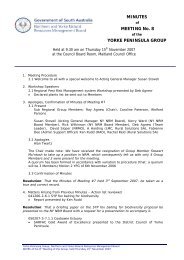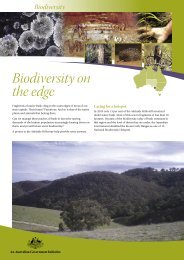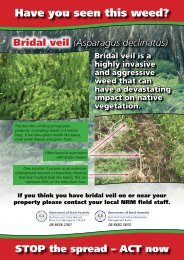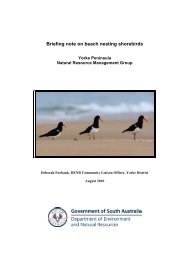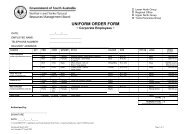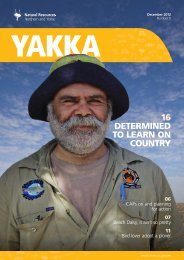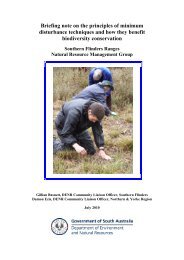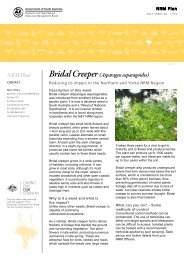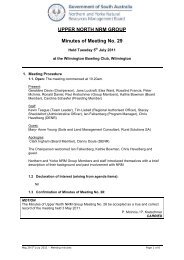Caring for country - Northern and Yorke Natural Resources ...
Caring for country - Northern and Yorke Natural Resources ...
Caring for country - Northern and Yorke Natural Resources ...
Create successful ePaper yourself
Turn your PDF publications into a flip-book with our unique Google optimized e-Paper software.
4ground work<br />
upper north<br />
lower north<br />
Walk on the wild<br />
orchids side<br />
Above: Ecologist Dr Eri Mulder with a couple of sleepy lizards at Buckaringa Sanctuary in Quorn. Photo: Kaz Bowl<strong>and</strong><br />
It is easy to be captivated by the natural beauty of<br />
Spring Gully Conservation Park - spanning rocky<br />
s<strong>and</strong>stone outcrops, steep-sided valleys <strong>and</strong> flowing<br />
cascades following heavy rain.<br />
Situated south-west of Clare, this picturesque park of 400<br />
hectares was set aside to conserve the State’s westernmost<br />
population of red stringybark (Eucalyptus macrorhyncha).<br />
It is the only reserve in South Australia featuring this species.<br />
However, the area that once provided an abundance of food<br />
<strong>for</strong> the Ngadjuri people prior to European settlement, is also a<br />
showcase of diverse grassy woodl<strong>and</strong> with a tapestry of native<br />
orchids that flower in Spring.<br />
It was on an orchid trail walk about 15 years ago that Elaine<br />
van Dijk <strong>and</strong> her husb<strong>and</strong>, Charlie, fell in love with the park<br />
that embraces the me<strong>and</strong>erings of the Spring Gully Creek <strong>and</strong><br />
Iron Pot Creek.<br />
“I have a passion <strong>for</strong> preserving our natural resources, <strong>and</strong> the<br />
unique features of the park had an immediate impact on me,”<br />
said Elaine, who is now president of the Friends of Spring<br />
Gully volunteer group.<br />
Rock stars<br />
Spotting a yellow-footed rock wallaby is the highlight<br />
of the famous ridge-top tours of the spectacular<br />
scenery of Arkaroola in the northern Flinders Ranges.<br />
Turning off the engine of the Toyota <strong>and</strong> quietly watching<br />
a family of the strikingly beautiful yellow-footed rock<br />
wallabies interact with each other, <strong>and</strong> stare back at you<br />
serenely, is a moment you won’t <strong>for</strong>get.<br />
The yellow-footed rock wallaby is now listed as ‘vulnerable<br />
to extinction’ by the Australian <strong>and</strong> South Australian<br />
Governments. Getting a glimpse of these macropods that<br />
call the mountain ridges of northern South Australia home, is<br />
becoming a rare event.<br />
But at the Buckaringa Wildlife Sanctuary near Quorn, the<br />
Australian Wildlife Conservancy is playing a vital role in<br />
helping the colorful wallabies to survive <strong>and</strong> prosper in<br />
semi-arid areas where they live among the steep cliffs, rocky<br />
outcrops <strong>and</strong> nearby caves.<br />
The once abundant yellow-footed rock-wallabies have been<br />
decimated by intense hunting <strong>for</strong> the fur trade in the past,<br />
their habitats destroyed by goats, sheep <strong>and</strong> rabbits <strong>and</strong> fatal<br />
attacks from feral cats <strong>and</strong> foxes.<br />
Low numbers <strong>and</strong> competition from goats are the two most<br />
significant ongoing threats that have reduced the species to<br />
dangerously low numbers.<br />
Colonies once healthy <strong>and</strong> vigorous, are down to a h<strong>and</strong>ful<br />
<strong>and</strong> the little family groups are so isolated from each other<br />
that they are extremely vulnerable to regional catastrophic<br />
events, loss of genetic diversity <strong>and</strong> any habitat loss or<br />
disturbance.<br />
Buckaringa Sanctuary, 30km north of Quorn, covers<br />
2000 ha of the southern Flinders Ranges. It is owned<br />
by Australian Wildlife Conservancy (AWC), a non-profit<br />
organisation dedicated to the conservation of Australia’s<br />
threatened wildlife.<br />
Since being acquired by the AWC, Buckaringa has been<br />
cleared of feral plants <strong>and</strong> animals with the help of<br />
volunteers <strong>and</strong> the results are being assessed – with two<br />
baseline studies into the flora <strong>and</strong> fauna.<br />
The surveys are being carried out with funding support<br />
from <strong>Northern</strong> <strong>and</strong> <strong>Yorke</strong> NRM Board <strong>and</strong> with the help of<br />
dozens of volunteers.<br />
Buckaringa wildlife ecologist, Keith Bellchambers said two<br />
surveys had been carried out in the past 12 months –<br />
the first on fauna <strong>and</strong> the second on the flora of the<br />
wildlife sanctuary.<br />
He said the survey results would help AWC come up with<br />
better conservation <strong>and</strong> l<strong>and</strong> management practices.<br />
The first fauna survey was completed in late spring 2009 by<br />
AWC staff <strong>and</strong> local volunteers. The survey covered 18 sites<br />
<strong>and</strong> recorded 18 mammal species, 73 bird species,<br />
29 reptiles <strong>and</strong> a single frog species.<br />
The second baseline biodiversity study established a series<br />
of vegetation survey <strong>and</strong> monitoring sites in a range of<br />
plant communities that occur on the sanctuary. Native<br />
plants were measured <strong>for</strong> re-growth following the culling<br />
of more than 1000 goats.<br />
Another important part of the survey was to find out the<br />
rate of recovery of areas of the <strong>for</strong>mer sheep station that<br />
had been contour-furrowed in the past.<br />
“Vegetation recovery in these semi-arid areas is a<br />
slow process dependent on seasonal conditions <strong>and</strong><br />
ongoing management of total grazing pressure,”<br />
Mr Bellchambers said.<br />
AWC owns <strong>and</strong> manages 21 properties covering more<br />
than 2.5 million hectares around the county. Volunteering<br />
opportunities <strong>for</strong> Buckaringa as well as some of its<br />
other sanctuaries are outlined on its website at: www.<br />
australianwildlife.org<br />
Above: White beauty spider-orchid (Caladenia argocalla). Its range is<br />
limited to the Barossa Valley, Clare Valley <strong>and</strong> Adelaide Hills regions,<br />
<strong>and</strong> is listed as Endangered under the Australian EPBC Act <strong>and</strong> the SA<br />
National Parks <strong>and</strong> Wildlife Act. Photo: Mick Higgins.<br />
6 <strong>Northern</strong> <strong>and</strong> <strong>Yorke</strong> <strong>Natural</strong> <strong>Resources</strong> Management Board




